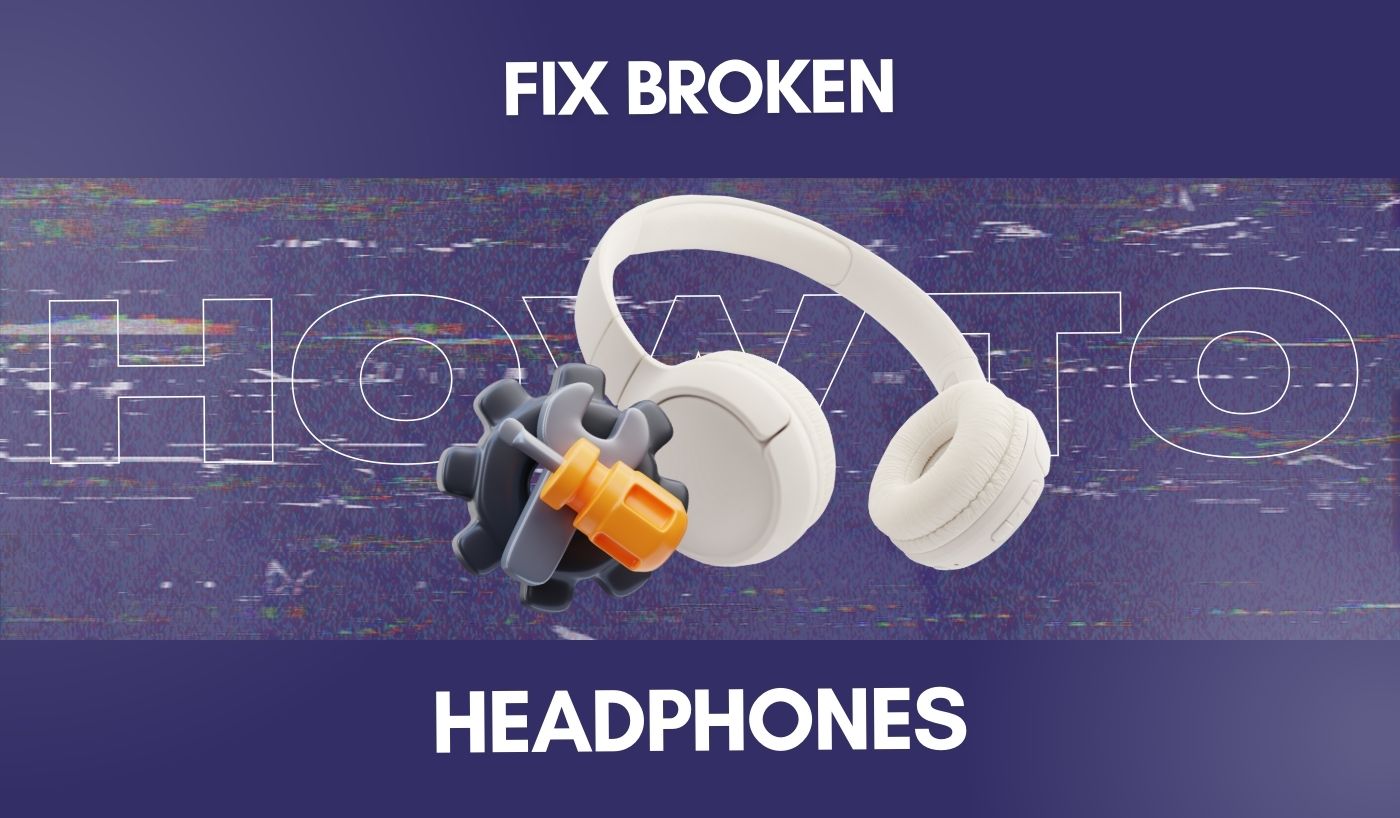Disclaimer: Please verify the warranty on your headphones before beginning any repairs yourself. If at all feasible, talk with the headphones manufacturers about experienced problems. Then, look for replacing or repairing headphones.
Do you have broken headphones? Broken headphones may have evident physical damage or not. If you can see the physical issue, it is rapid to identify. But what about hidden problems? You can resolve unknown problems with your headphones by hearing sound quality.
Yet, you must identify the problem’s spot first. If your headphones are unbroken, to begin with, why would you want to fix them? There are two techniques to determine whether your headphones are broken, and they are as follows:
Test various audio sources. Consider connecting your headphones to several audio sources to check for changes in what you hear. The issue is most likely with the original audio source rather than the headphones if you find the fades when you change audio sources.
Better Files to Play: In certain circumstances, the audio issues might bring poor music quality. You shouldn’t anticipate the highest audio quality from a music file named “eMINem – STann.mp3” that you obtained from Limewire in the early 2000s.
- Try playing some high-quality music that you may find on Spotify or YouTube instead.
- Or try classical music, zany instrumentals, or jazz with good bass. Typically, they cover all frequencies.
So, if you’re sure your headphones have problems, you should read this article. It includes some of the issues you could be having and the related do-it-yourself fixes.
How to Know My Headphone Has Problems?
1. You Hear Distorted or Rattling Sounds.
Headphone drivers that have been damaged or blown out are typically the cause of this issue. Blown-out headphone drivers might be caused by a variety of factors, some of which include:
Physical harm: Headphones that have been physically harmed may not produce sound properly. This can happen if you walk on your headphones, drop them, cram them inside a bag with heavy books, let your pet chew on or drop them, or stuff them inside a backpack.
Playing at maximum volume: High levels not only strain your ears and hearing unnecessarily. Moreover, it increases the pressure on the headphones’ drivers.
Too much power from the Amp: Headphone amps give the headphones extra power. Your drivers might be destroyed if you use an unreliable amp with improper settings or provide more power than the headphones can manage.
Hair, grime, or dust: Cleaning your headphones is necessary, just like cleaning other electrical gadgets. Dust, hair, or grit can collect inside your headphone drivers. It makes noises like rattling, buzzing, or scratching.
2. On your Bluetooth headphones, you Feel No Sound.
Your Bluetooth headphones may occasionally connect properly, but no sound will play. There are several potential causes for this issue in this instance:
- The sound quality: Loudness output of the headphones can be affected by audio source settings, regardless of the sort of device you’re using. If this is the issue, fixing these settings might not be difficult.
- Necessary Updates: The performance of a mobile phone or audio driver may suffer for several reasons.
3. When using Bluetooth Headphones, there is a Delay.
The audio desync issue is obvious. Due to a phenomenon known as audio delay, wireless headphones are also where it is most prevalent. When the sound source and your headphones are out of sync or delayed, it is an audio latency.
This issue might perhaps be brought on by:
- Incorrect audio codecs: AptX HD, AptX, or APtX LL codecs are recommended for the greatest sound quality. Audio codecs are software or algorithms that compress/encode your music data in a format for transmission. Using the incorrect audio codecs or mismatching them might cause various issues with sound output.
- Mismatched Bluetooth versions: For instance, if your audio source only supports Bluetooth 4.1, but your headphones have Bluetooth 5.0, this might cause a delay issue.
4. Using Wireless Headphones Produces Static
One of the more frequent problems is hearing static when wearing wireless headphones. Most people attempt to fix this by twisting the headphone plug. Yet it’s obvious that this isn’t the best option available.
The following are some potential reasons for this problem:
- Audio Settings: This issue typically arises when your device’s audio settings have been altered unnecessarily, your drivers become faulty, or you undergo a system upgrade.
- Connection Problems: Moving too far away from your audio device or experiencing physical interference might cause issues with wireless headphones. Aux ports that are filthy and lose wire connections are additional common issues with connected headphones.
- Speaker Damage on Headphones: Issues with audio output might result from speaker damage on headphones. When you deal with headphones improperly, this occurs (dropping them on the floor, stepping on them, accidentally sitting on them, etc.)
5. You have a Bent Headphone Jack or Plug.
Plugs and jacks for headphones are frequently used interchangeably. Yet, these are two distinct things. The sockets into which headphone plugs are inserted to receive audio signals are headphone jacks.
Many difficulties, including static noises, poor volume, and trouble with stereo mode, might be brought on by a bent headphone connector. Often, this occurs when force is exerted on the jack or plug while it is attached.
Steps to Fix Broken Headphones
It’s not difficult to fix faulty headphones; you need to follow the provided instructions carefully.
Step 1: Compile the Necessary Supplies
Gather all the equipment needed to repair the plastic on your headphones. The required supplies include:
- An adhesive
- Wood adhesive
- A transparent polish (non-compulsory)
- A blade or knife for cutting the cotton.
Go to the following stage once you have all the indicated supplies available.
Step 2: Sort the Shattered Bits.
Gather all the fragments of your headphones’ shattered plastic and set them aside to use later.
Step 3: Place Cotton Balls with Super Glue.
Take some super glue and a cotton ball to use as a tool. Ensure you have two or three cotton balls soaked in glue earlier to replace them as necessary quickly. You won’t have to interrupt your progress in the middle of it this way.
Step 4: Put Adhesive on the Headphones.
Once you have coated the cotton with adhesive, you may proceed. Apply the first coat of adhesive on the plastic of the headphones for this phase. To correctly apply glue through the damaged components, use an Exacto knife (or any non-sharp-edged object).
Step 5: To Enhance Further Protection, add Wood Glue.
Apply some wood glue on top of the superglue covering. This will assist in adding a layer of protection to the plastic. Make sure you have two or three cotton balls soaked in glue earlier to replace them as necessary quickly. You won’t have to interrupt your progress in the middle of it this way.
Step 6: Let your Headphones Air-Dry.
Let your headphones cure for an hour at room temperature after applying the adhesive correctly. A dryer might be used as additional assurance.
Step 7: Add a Second Layer.
Apply a second coating on your headphones after the first one has dried to repair the damaged components. Once more, let them air dry.
Step 8: Tape the Area.
Cover up the damaged components with electrical tape. If necessary, you can cut the tape with a knife. Cut off the extra tape, for instance, if it is blocking the headphone jack.
Tip: Spray paints the electrical tape after you’ve applied it if you can’t locate the proper color.
Step 9: Use a Varnish
This step has a big impact if taken. Cover any cracks with a transparent varnish or sealer, such as clear nail polish. So that they won’t acquire any scratches the next time you accidentally drop your headphones or stuff them into your backpack. These will also stop dirt from building up.
Be sure you apply a second coat on top of the first one once it has dried. Wait until the first coat has dried completely before applying the second. Continue doing this until you get the outcome you want.
Step 10: Wait Until the Headphones are Dry.
You only need to wait until your headphones are dry for the final procedure. It is advised to wait at least 24 hours before using it.
Conclusion
Not everyone finds it easy to say goodbye to a nice pair of headphones. Learning how to solve difficulties is thus a vital skill to have.
This advice should have assisted you in determining why your headphones keep breaking. Regardless of whether the problem is visible or not, solutions mentioned in this guide are necessary to treat it.




